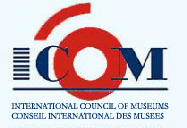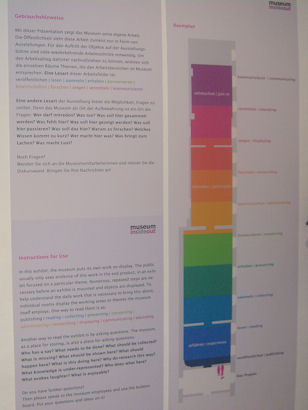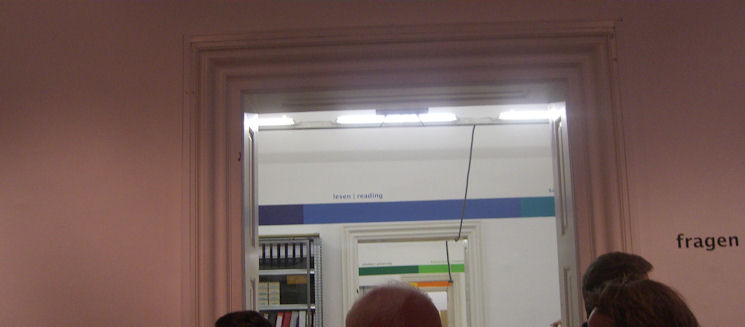 |
|
|||
|
REISERAPPORT
“Museum_inside_out” – an outside look for the insiders ICOMs generalkonferanse i Wien august 2007 The Austrian Museum of Folk Life and Folk Art had set up three exhibition rooms to display the different parts of the museum work process; publishing, reading, collecting, preserving, conserving, administering, researching, displaying, educating, communicating. Parallel to this list, visitors were encouraged to experience, participate, join in! Each field was given a colour, from blue to purple, as seen in the user manual below. The three rooms were set up with complete work stations, including “real” museum staff working with artefacts. The staff members who sat “on display” in the exhibition were all introduced by a colour-bar indicating how much the various staff members worked with the different museum disciplines, as depicted below. |
 |
|
|||
|
User manual and exhibition layout to the left, staff presentations to the right. |
||||
 A sequence of colour-coded bright rooms.. |
| The rooms were all white and bright, and marked with vivid colours, in stark contrast to the
permanent exhibitions on the first floor. The permanent exhibitions were dark and crowded, and very traditional. After visiting “Museum_inside_out”, we were offered treasure-hunt
sheets; women were to search for male artefacts and vice versa. The conventional form of the exhibition as well as the sheets added to the interesting contrast between the two floors
of the museum. The “Museum_inside_out” project was introduced very openly; we don’t really know what we want to get out of this, maybe you can help us? Director Margot Schindler writes: |
||||
| “The project itself is experimental, and the process is open. (…) We want to break through the conventions to start a dialogue about the museum that is not just conducted by experts
but also in collaboration with visitors. In spaces and places where objects can be seen without benefit of specific settings or pre-ordained interpretations, it is easier to ask questions
about their meaning, or their topicality, or even how one perceives them. The museum itself would like to build on this dialogue for its own future, whether in terms of exhibit contents,
programmatic plans, or organizational mandates. (…) Ask questions, please, of the museum. And pose questions to those who work in the museum. Write down your suggestions and questions.
Give us feedback. Communicate!” |
| I found the innermost room the most enjoyable. Her they had set up a large table filled with
artefacts they weren’t really sure about, asking the public for help; some of the artefacts with specific questions attached. Some of us gathered around making imaginative suggestions.
Others took the task more seriously and brought in various experts who were present at the excursion, and old pictures of Norwegian folk costumes were deciphered. |
||||
|
|
| The interesting thing was not so much the actual artefacts and the real “live” museum staff.
As museum employees, we see these things every day. The inspirational aspect for me was in the concept itself, bringing the museum “backstage” into the gallery space and putting it on
display. As an educator I move back and forth between the two, and sometimes they feel like different worlds. As a young newcomer, for me the ICOM conference felt a little like a “museum_inside_in”, an inside display, open exclusively for insiders. But without the explicit open questions. In the ICME conference program, no time was set aside for questions. And as papers exceeded their time limit, questions were limited to one or two per paper. It occurred to me, that some of the presentations were written articles read out loud, and that not all the presentations seemed equally useful in elaborating on the ICME theme, “The World under One Roof: Past, Present and Future Approaches to Universality”. While some present at the conference may attend similar gatherings regularly, others, especially museum colleagues from developing nations, may not have the same opportunities. After our visit to the “Museum_inside_out” it seemed to me that more time could have been spent asking questions and encouraging dialogue amongst colleagues from different parts of the world. But then, in such a large gathering, days could be spent in dialogue without any concrete results. The advantage of the Austrian Museum of Folk Life and Folk Art is its limited size. Open questions and experimental projects like “Museum_inside_out” would be difficult to manage at a larger institution. Nevertheless, I found the whole experience very inspirational and thought provoking, and I am very grateful to have been given this opportunity. |
||||
| ▲ til toppen Tilbake til reiserapporter 2007 |